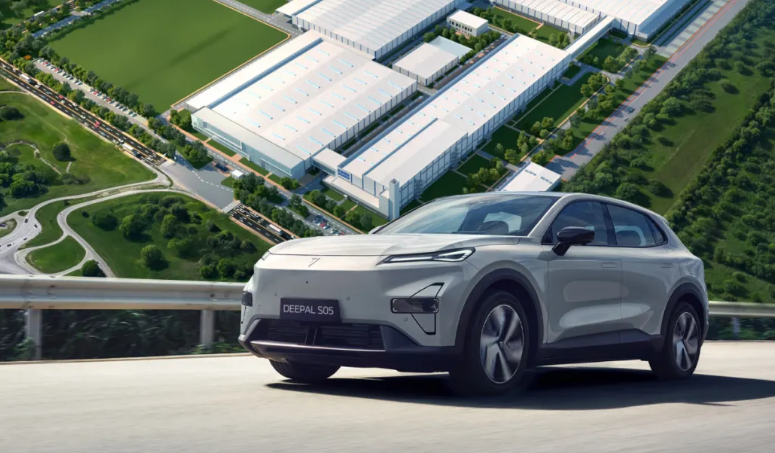Investment Landscape of China’s Electric Vehicle Industry Shifts, Overseas Surpasses Domestic for the First Time, Battery Companies Become Main Force
Recently, a research report released by Rhodium Group showed that in 2024, for the first time, overseas investment by Chinese electric vehicle industry chain enterprises surpassed domestic investment. Despite higher costs, delays, and risks faced by overseas projects, this shift has still occurred, marking a "historic transformation" in the investment landscape of China's electric vehicle industry.
According to data from the Rhodium Group, Chinese electric vehicle industry chain companies are expected to invest approximately $16 billion overseas in 2024, a figure slightly higher than the $15 billion investment domestically. In comparison, nearly 80% of investment in this industry used to be concentrated domestically.

Image source: Changan Automobile
So, what is the driving logic behind this transformation? What challenges will enterprises face in their overseas expansion? And how should they break through and move forward in the future?
Differences between domestic and international markets drive the investment focus towards overseas.
The investment in China's electric vehicle industry has shifted from "domestic-led" to "overseas breakthrough," essentially as a result of the combined effects of changes in both domestic and international market environments.
In the domestic market, the long-term rapid development has gradually led the industry into a "saturation period," with the investment space continuously narrowing. In the past, China, with its large consumer base, comprehensive industrial chain support, and policy incentives, became the world's largest electric vehicle market, attracting a massive influx of capital. However, as production capacity rapidly expands, the market supply-demand relationship has gradually become imbalanced, with the problem of overcapacity increasingly prominent. Coupled with price wars initiated by companies competing for market share, the profit margins across the entire industrial chain have been severely compressed. From vehicle manufacturers to battery suppliers, and down to downstream component companies, profits have generally declined, and the domestic investment return rate continues to decrease.
In sharp contrast to the "cooling down" of the domestic market, the overseas market is experiencing a "rising period" of rapidly growing demand for electric vehicles and holds significant strategic value, becoming a core motivation for Chinese companies to establish a presence. To achieve carbon reduction goals, regions such as Europe, North America, and Southeast Asia have introduced encouraging policies: Europe stimulates consumer purchases through subsidies and tax incentives, North America increases investment in charging infrastructure, and Southeast Asia, leveraging its demographic dividend and market potential, is becoming a new growth pole. More critically, overseas expansion can help companies circumvent trade barriers and reduce costs.
Against this backdrop, Chinese enterprises are accelerating their overseas expansion.For example, as the world's largest electric vehicle battery manufacturer, CATL stated in June this year that due to the fierce competition in the domestic Chinese automotive market, overseas expansion has become its "top priority." BYD, China's top-selling electric vehicle manufacturer, has factories in Brazil and Thailand and plans to build plants in Turkey and Indonesia. Chery Automobile plans to invest $1 billion to build an electric vehicle factory in Turkey.

Image source: CATL
It is worth noting that battery manufacturers have become the absolute main force in this wave of overseas investment. According to data from the Rhodium Group, about three-quarters of the foreign investment comes from battery manufacturers.
High transportation costs and the demand for localized supply are the main driving forces behind battery manufacturers' overseas investments. Power batteries are large in size and heavy in weight, resulting in high transportation costs. Moreover, automakers are increasingly demanding localized supply to ensure supply chain stability. The report states that major Chinese battery manufacturers such as CATL and Gotion High-Tech are following in the footsteps of international clients like Tesla and BMW to expand into overseas markets, driven by high transportation costs and overseas customers' requirements for localized supply.
Challenges of Overseas Investment and the Future of the Industry
Despite the strong momentum of overseas investment by Chinese electric vehicle industry chain enterprises, the complexity of overseas markets far exceeds that of the domestic market, and companies face multiple challenges including costs, timelines, regulatory, and political risks.
In terms of costs, overseas projects generally face higher expenses for land acquisition, plant construction, and labor compared to domestic projects. Regarding timelines, domestic battery factories can typically begin construction within 3 to 12 months, whereas overseas projects must contend with complex approval processes, local environmental standards, and building codes, often requiring 10 to 24 months. This significantly increases capital occupancy costs and market uncertainties.
Regulatory and political risks are major obstacles to overseas expansion for companies. Different countries have vastly different environmental standards, safety certifications, and data compliance requirements for electric vehicles, necessitating significant resource investment from companies to adapt. Fluctuations in the political landscape add further uncertainty, as geopolitical conflicts may disrupt supply chains and sudden policy changes can directly impact project progress. According to data from the Rhodium Group, only 25% of announced overseas electric vehicle manufacturing projects have been completed, whereas the completion rate for projects within China is 45%.
Despite the many challenges, the "historic shift" where overseas investment surpasses domestic investment has opened up new opportunities for the globalization of China's electric vehicle industry.
From a long-term perspective, overseas expansion can help enterprises integrate more deeply into the global industrial chain: at the technological level, companies can leverage overseas R&D centers and talent resources to collaborate with internationally advanced enterprises, accelerating breakthroughs in cutting-edge technologies such as solid-state batteries and battery recycling; at the market level, localized production enables companies to more accurately capture local consumer demands—for example, European consumers place greater emphasis on vehicle safety and design, while the Southeast Asian market has a strong demand for economical models. Targeted product adjustments can further increase market share. Meanwhile, the establishment of overseas factories can also drive upstream domestic material and equipment companies to "go global," forming a global layout of the entire industrial chain and enhancing the discourse power of China's electric vehicle industry within the global value chain.

Image Source: Chery Automobile
For enterprises, the key to addressing overseas challenges lies in formulating a "refined" investment strategy. During the investment decision-making phase, it is essential to form a professional team to conduct in-depth research on the target market's political environment, legal system, and cultural customs, and to assess the stability of policies and the potential of market demand, in order to avoid blind expansion. During project implementation, companies should strengthen communication with local governments, communities, and unions, and actively fulfill social responsibilities. For example, in the construction of its factory in Hungary, CATL simultaneously advanced local employee training and environmental facility upgrades, earning recognition from the local government and residents. Additionally, companies can reduce risks through joint ventures, collaborations, and technology licensing. For instance, Chery's joint venture model with Spain's EV MOTORS not only allows for rapid implementation by leveraging local resources but also helps circumvent certain trade barriers.
The transformation of the investment landscape in China's electric vehicle industry is not a short-term "policy-driven" or "market speculation" phenomenon, but rather an inevitable choice for the industry to shift from "scale expansion" to "quality improvement" and from "domestic leadership" to "global competition." In the context of the accelerated iteration of the global electric vehicle industry, Chinese companies must face overseas challenges squarely and advance their global expansion with more mature strategies and steadier steps. Only then can they take the initiative in international competition and lay a solid foundation for the long-term development of China's electric vehicle industry.
【Copyright and Disclaimer】The above information is collected and organized by PlastMatch. The copyright belongs to the original author. This article is reprinted for the purpose of providing more information, and it does not imply that PlastMatch endorses the views expressed in the article or guarantees its accuracy. If there are any errors in the source attribution or if your legitimate rights have been infringed, please contact us, and we will promptly correct or remove the content. If other media, websites, or individuals use the aforementioned content, they must clearly indicate the original source and origin of the work and assume legal responsibility on their own.
Most Popular
-

EVA Morning Prices on September 12: Most of the Market Holds Steady, Highest Rise of 50 Yuan
-

Vynova's UK Chlor-Alkali Business Enters Bankruptcy Administration!
-

[PET Weekly Outlook] Polyester Bottle Chips Expected to Oscillate and Warm Up with Costs Today
-

Nissan Cuts Production of New Leaf EV in Half Due to Battery Shortage
-

Case Study | Clariant AddWorks™ Additives Solve Plastic Yellowing Problem






